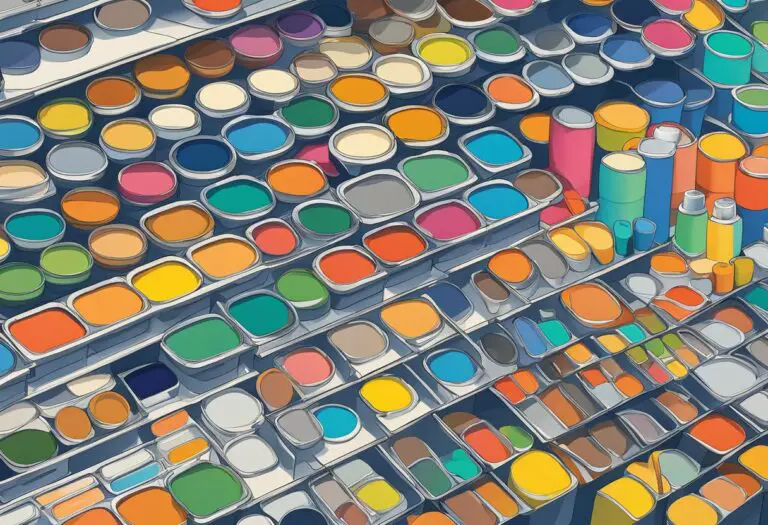Best Painting Masking Tape for Clean Edges
When it comes to achieving clean edges and flawless finishes on your DIY or professional painting projects, a reliable painting masking tape is an essential tool. The right tape can make a significant difference in the final outcome of your paint job, ensuring sharp lines and minimizing paint bleed.
But with so many options available in the market, how do you choose the best painter’s tape for your needs? In this article, we will guide you through the top-rated brands, different types, and important considerations when purchasing painting masking tape. Whether you’re a seasoned painter or a DIY enthusiast, we’ve got you covered.
Key Takeaways:
- Choosing the right painting masking tape is crucial for achieving clean edges and professional-looking paint lines.
- Top-rated brands offer features like excellent adhesion, clean removal, and reduced paint bleed.
- Different types of painting masking tape cater to specific applications, such as precision masking tape for detailed work.
- Quality masking tape ensures cleaner lines, reduces touch-up efforts, and makes paint application easier and more precise.
- Proper tape application and removal techniques are essential for maximizing the benefits of painter’s tape.
Understanding the Importance of Painter’s Tape
Painter’s tape is a crucial tool for achieving precise and professional-looking paint lines in any painting project. Whether you’re a DIY enthusiast or a professional painter, mastering the use of masking tape techniques is essential for creating flawless finishes and clean edges.
One of the primary uses of painter’s tape is to create sharp lines between different colors or surfaces. By applying masking tape before painting, you can prevent paint bleeding and ensure crisp edges. This technique is particularly important when working on intricate designs or when transitioning between different colors.
Masking tape for painting can also be used as a guide for straight lines, curves, or complex patterns. By carefully placing tape along the desired path, you can achieve precise shapes and avoid uneven lines. This technique is especially beneficial for creating geometric patterns or intricate trim work.
When using painter’s tape, it’s important to ensure that the tape is firmly pressed onto the surface. This helps prevent paint from seeping underneath the tape and ensures clean, sharp lines.
In addition to achieving clean lines, painter’s tape can also simplify the painting process. It acts as a barrier, protecting surfaces that you don’t want to paint. This includes baseboards, window frames, and other areas where precision is required. By using masking tape, you can work more confidently and efficiently, knowing that your paint will only go where you want it to.
While painter’s tape techniques may seem straightforward, mastering them requires practice and attention to detail. It’s essential to choose the right type and quality of masking tape for your specific project. Additionally, proper application and removal techniques are crucial to achieving the desired results without damaging the underlying surfaces.
Common Painter’s Tape Techniques:
- Straight Line Technique: Use painter’s tape to create crisp straight lines between different colors or surfaces.
- Curves and Patterns: Apply masking tape along curved lines or intricate patterns to ensure precision and clean edges.
- Trim Protection: Utilize painter’s tape to safeguard trim, baseboards, and other areas from accidental paint splatters or smudges.
- Freehand Guides: Create freehand guides by placing painter’s tape in the desired shape or path for accurate and even strokes.
By understanding the importance of painter’s tape and mastering these techniques, you can elevate the quality of your painting projects and achieve professional-looking results. Whether you’re painting walls, furniture, or art pieces, masking tape is an indispensable tool in your arsenal.
Top-rated Painter’s Tape Brands

When it comes to achieving clean and professional paint lines, using top-rated painter’s tape is essential. High-quality painter’s tape not only prevents paint bleed and creates sharp edges, but it also ensures easy removal without leaving any residue behind. In this section, we will explore some of the best brands of painter’s tape available in the market.
FrogTape
FrogTape is renowned for its patented PaintBlock Technology, which forms a micro-barrier that seals the edges of the tape, preventing paint bleed. This top-rated painter’s tape is known for its excellent adhesion and clean removal, making it a favorite among professional painters.
ScotchBlue
ScotchBlue painter’s tape is widely trusted by DIY enthusiasts and professional painters alike. Its advanced adhesive technology stick well to surfaces, ensuring clean and straight paint lines. ScotchBlue painter’s tape offers a wide range of options, including delicate surfaces tape and multi-surface tape, providing versatility for various painting projects.
3M
3M is a reputable brand known for manufacturing high-quality painter’s tape that meets the needs of professionals. With its excellent adhesion, easy removal, and resistance to paint bleed, 3M painter’s tape ensures precise and clean results. It is available in different widths to cater to different project requirements.
Shurtape
Shurtape painter’s tape is highly regarded for its durability and excellent paint adhesion. The strong tape backing ensures clean lines and minimal paint bleed, making it a favorite among professional painters. Shurtape offers a range of options, including delicate surface tape, giving users the flexibility to handle various surfaces.
These top-rated painter’s tape brands have been tested and highly recommended by users in both DIY and professional painting projects. Whether you are tackling a small room or a large-scale project, choosing a reputable brand like FrogTape, ScotchBlue, 3M, or Shurtape ensures superior performance and flawless results.
Types of Painting Masking Tape
When it comes to painting projects, selecting the right type of masking tape is essential for achieving clean and precise results. There are various options available in the market, each designed to cater to specific needs and surfaces. Understanding the different types of painting masking tape can help you choose the most suitable one for your project. Two common types of tape worth considering are painting masking tape and precision masking tape.
Painting Masking Tape
Painting masking tape is a versatile option that is widely used in both DIY and professional painting projects. It offers excellent adhesion to surfaces and is designed to be easily removed without leaving behind any residue or damaging the surface. This type of tape is ideal for creating crisp and clean paint lines on walls, trim, and other large surface areas.
Precision Masking Tape
Precision masking tape, as the name suggests, is specifically designed to provide precise and accurate results. It has superior adhesion and is perfect for achieving intricate designs and detailed paint lines. Precision masking tape is commonly used in artistic projects, murals, and other applications where precise control is required. It ensures that paint does not bleed or seep through, resulting in sharp and flawless edges.
Regardless of the type of painting masking tape you choose, it is important to ensure that it is of high quality. Look for brands that are known for their performance and reliability. It’s also advisable to read user reviews and consider recommendations from experienced painters to get a better understanding of which tape will work best for your specific project.
| Type of Tape | Features | Uses |
|---|---|---|
| Painting Masking Tape | – Excellent adhesion – Easy removal without residue – Suitable for large surface areas |
– Creating clean paint lines on walls and trim |
| Precision Masking Tape | – Superior adhesion – Prevents paint bleed – Ideal for detailed designs and precise lines |
– Artistic projects – Murals – Intricate detailing |
The Benefits of Using Quality Masking Tape
Using high-quality masking tape in painting projects offers several benefits that contribute to achieving professional-looking results. Whether you’re a DIY enthusiast or a professional painter, investing in the best painter’s tape can greatly improve the quality of your work.
1. Cleaner Lines
One of the key advantages of quality painting masking tape is that it provides clean and crisp lines. The tape’s adhesive properties allow it to adhere firmly to surfaces, preventing paint bleed and ensuring that the edges of your painted areas are sharp and well-defined.
2. Reduced Paint Bleed
Paint bleed can be a common problem that affects the overall appearance of a paint job. However, using the best painter’s tape helps minimize this issue. The tape’s precise edges create a barrier that prevents paint from seeping underneath, resulting in cleaner and more professional-looking finishes.
3. Easier Touch-Ups
When it comes to touch-ups or correcting mistakes, quality masking tape proves to be invaluable. The tape’s clean removal ensures that you can easily make adjustments or fix any imperfections without damaging the existing paintwork. This saves time and effort, allowing for seamless touch-ups with minimal hassle.
Quality masking tape guarantees clean lines, reduced paint bleed, and easier touch-ups, resulting in flawless finishes that showcase your painting skills.
By investing in the best painter’s tape available, you create a professional painting environment that enhances your overall painting experience. The premium quality of the tape ensures that you achieve precise, clean, and visually appealing results in your painting projects.
| Benefits of Using Quality Masking Tape |
|---|
| Cleaner Lines |
| Reduced Paint Bleed |
| Easier Touch-Ups |
Tips for Applying Painter’s Tape
When it comes to achieving clean and professional paint lines, proper application of painter’s tape is crucial. Whether you’re working on a DIY project or handling a larger painting job, these practical tips and techniques will help you use painter’s tape effectively. From surface preparation to tape removal, following these guidelines will ensure you achieve the best results.
1. Surface Preparation:
Before applying painter’s tape, it’s essential to prepare the surface properly. Clean the area to be painted, ensuring it is free from dust, dirt, and debris. Additionally, make sure the surface is dry and smooth to allow the tape to adhere properly.
2. Choose the Right Tape:
Not all painter’s tapes are created equal. Consider the type of tape that best suits your project. For delicate surfaces, such as wallpaper or freshly painted walls, use a low-adhesive tape to avoid any damage. For more durable surfaces, such as trim or baseboards, opt for a tape with higher adhesion to ensure clean lines.
3. Proper Tape Application:
When applying painter’s tape, ensure it is straight and firmly pressed onto the surface. Use a putty knife or your fingers to firmly press down the edges of the tape to create a tight seal. This will prevent any paint from bleeding underneath and ensure clean lines when the tape is removed.
4. Overlapping Tape:
For large areas or complex shapes, overlapping the painter’s tape slightly can help create smoother lines. By overlapping the edges of the tape slightly, you create a barrier that prevents any paint from seeping through. Just make sure the tape is overlapped evenly to avoid uneven paint lines.
5. Removing Tape:
After completing the painting job, it’s crucial to remove the tape carefully for clean lines. Start by peeling it back at a 45-degree angle to prevent any paint from lifting. If the paint has dried, use a utility knife to score the edges of the tape before peeling it off. Remember to remove the tape slowly and evenly to avoid any damage or residue on the painted surface.
By following these tips and techniques for applying painter’s tape, you can ensure clean edges and professional-looking paint lines on all your DIY projects. Whether you’re a seasoned painter or a beginner, these guidelines will help you achieve flawless results with ease.
Perfecting Paint Touch-Ups with Masking Tape
When it comes to achieving flawless paint touch-ups and small repairs, precision is key. That’s where paint touch-up tape and precision masking tape come into play. These innovative products are designed specifically to help you create seamless touch-ups, ensuring that your finished results are as professional-looking as possible. In this section, we will explore how to use these tapes effectively and provide step-by-step instructions for perfecting paint touch-ups.
Step 1: Surface Preparation
Before starting your touch-up project, it’s crucial to properly prepare the surface. Clean the area to be painted, removing any dust, dirt, or grease. If necessary, sand the surface gently to ensure a smooth finish.
Step 2: Apply the Paint Touch-Up Tape
Once the surface is prepped, it’s time to apply the paint touch-up tape. Start by cutting a piece of precision masking tape to the desired length. Carefully align the tape along the edges of the touch-up area, pressing it firmly onto the surface to ensure a secure bond.
Step 3: Paint Application
With the tape in place, you’re ready to apply the paint. Use a small brush or a touch-up pen to carefully fill in the damaged or discolored area. Take your time and apply thin, even coats of paint, allowing each coat to dry before applying the next. This will help prevent paint buildup and ensure a seamless blend with the surrounding surface.
Step 4: Remove the Paint Touch-Up Tape
Once the paint has dried to the touch, it’s time to remove the paint touch-up tape. Gently peel the tape back at a 45-degree angle, being careful not to disturb the freshly painted surface. This will help achieve crisp, clean edges and minimize the risk of paint peel or bleed.
Expert Tip: To further ensure clean lines, remove the tape while the paint is still slightly tacky. This will prevent the paint from fully curing and adhering to the tape, making removal even easier.
After removing the tape, allow the paint to fully dry before assessing the touch-up. If necessary, repeat the process with additional layers of paint until you achieve the desired coverage and seamless blend with the surrounding surface.
By following these step-by-step instructions and using paint touch-up tape or precision masking tape, you can easily perfect your paint touch-ups and small repairs. These tapes are invaluable tools that help you achieve professional results and maintain the visual integrity of your painted surfaces.
Choosing the Right Width of Painter’s Tape
When it comes to achieving clean and precise paint lines, choosing the right width of painter’s tape is crucial. The width of the tape plays a significant role in determining the level of accuracy and efficiency you can achieve in your painting projects.
Top-rated painter’s tape brands understand the importance of offering a variety of widths to suit different painting needs. Whether you’re working on intricate details or larger surface areas, having the appropriate tape width can make a noticeable difference in the final results.
For professional painter’s tape applications that involve complex patterns or delicate edges, opt for narrower widths, such as 0.5 inches or 1 inch. These widths allow for precise lines and meticulous attention to detail. They work exceptionally well in tight spaces and smaller painting projects.
On the other hand, when dealing with larger surfaces, wider painter’s tape widths, such as 1.5 inches or 2 inches, are ideal. These widths cover more area and ensure efficient masking. They are particularly useful when painting walls, ceilings, or other expansive surfaces.
Additionally, consider the scale of your painting project when selecting the tape width. If you’re working on a larger area, using wider tape can help you save time while maintaining accuracy. Conversely, smaller projects may require narrower tape widths to achieve intricate designs or prevent color bleeding.
It’s essential to remember that the width of the painter’s tape should be proportional to the surface area you’re masking. A tape that is too thin might not provide adequate coverage and could result in paint bleeding or uneven lines. Conversely, a tape that is too wide may be difficult to maneuver in confined spaces or create unnecessary bulkiness.
By choosing the right width of painter’s tape, you can ensure cleaner paint lines, minimize touch-ups, and achieve professional-quality results. Consider the scope of your project, the level of detail required, and the size of the surface to make an informed decision.
Removing Painter’s Tape for Clean Lines
Properly removing painter’s tape is crucial to achieving clean and sharp edges in your painting projects. When done incorrectly, it can result in paint bleed, tape residue, or even damage to the painted surfaces. Follow these techniques and tips to ensure a flawless finish:
- Timing is key: Remove the tape while the paint is still slightly wet but not fully dry. Waiting too long can make the tape more difficult to remove and may lead to peeling of the painted surface.
- Angle of removal: Gently pull the tape back at a 45-degree angle, parallel to the painted surface. This helps to create a clean break along the tape’s edge and minimizes the risk of tearing the paint or leaving behind residue.
- Slow and steady: Avoid pulling the tape too quickly, as this can cause the paint to lift or create jagged lines. Instead, pull the tape slowly and steadily, ensuring a smooth removal process.
- Use a sharp utility knife (optional): If you notice any stubborn or hard-to-remove sections of tape, you can carefully score along the edge with a sharp utility knife to facilitate clean removal.
- Inspect and touch up: After removing the tape, inspect the edges for any imperfections. If necessary, use a small brush or touch-up roller to fix any areas that require additional paint or touch-up.
By following these painter’s tape techniques, you can achieve clean lines and professional-looking results with ease. Remember, taking the time to remove the tape properly is just as important as applying it correctly.
Using Painting Masking Tape on Various Surfaces
Painting masking tape is a versatile tool that can be used on a variety of surfaces to achieve clean and professional results. Whether you are painting walls, furniture, or even delicate surfaces like glass or metal, using the best painter’s tape is crucial for precise masking.
One of the most common surfaces where painting masking tape is used is walls. Whether you’re painting a room or creating accent walls, painter’s tape can help you achieve clean and crisp lines. It prevents paint bleed and ensures that the edges of your painted surfaces are sharp and well-defined.
“Using painting masking tape on walls is essential to achieve those perfectly straight lines. It makes the painting process much more enjoyable and ensures a professional-looking finish.” – Sarah, DIY enthusiast
Another surface where masking tape is commonly used is furniture. When painting or refinishing furniture, painter’s tape can be applied to protect certain areas, such as hardware or trim, that you don’t want to paint. This allows for more precision and control over the paint application, resulting in a flawless finish.
For more delicate surfaces like glass or metal, using a painter’s tape specifically designed for these materials is recommended. These specialized tapes have the right adhesion and properties to adhere to smooth surfaces without causing any damage or leaving residue behind.
Recommended Painting Masking Tape for Different Surfaces:
- Interior walls: Use a medium adhesion painter’s tape that is suitable for indoor use.
- Furniture: Opt for a painter’s tape with low adhesion to avoid damaging the furniture’s finish.
- Glass and metal: Choose a painter’s tape specifically designed for these surfaces, ensuring it has the right properties to adhere without leaving residue or causing damage.
- Exterior surfaces: Look for a painter’s tape that is suitable for outdoor use, as it will be more resistant to weather conditions.
When using painting masking tape on various surfaces, always ensure that the surfaces are clean and free from dust or debris. This will help the tape adhere properly and prevent any paint bleed. Additionally, it’s important to apply the tape carefully and remove it at the right time to achieve the best results.
By selecting the best painter’s tape for the specific surface you are working on, you can ensure clean lines, precise masking, and professional-looking results in your painting projects.
How to Store and Preserve Painter’s Tape
Proper storage and preservation of painter’s tape are crucial to maintain its longevity and effectiveness. By following these simple tips, you can ensure that your professional painter’s tape remains in optimal condition for future use.
Keep the Original Packaging
When you purchase top-rated painter’s tape, it often comes in well-designed packaging that provides protection against dust, dirt, and humidity. It is recommended to store the tape in its original packaging to maintain its quality and prevent unnecessary exposure to external elements.
Store in a Cool and Dry Place
Excessive heat and moisture can degrade the adhesive properties of the painter’s tape. To preserve the tape’s performance, store it in a cool and dry place, away from direct sunlight, extreme temperatures, and high humidity. A drawer or cabinet in a controlled environment is an ideal storage location.
Avoid Contact with Solvents and Oil
Professional painter’s tape is designed to adhere well to various surfaces, but contact with solvents and oil can compromise its adhesive properties. When storing the tape, make sure it is kept away from solvents, oils, and other chemicals that can potentially affect its adhesive strength.
Protect the Edges
The edges of the painter’s tape are crucial for clean and precise lines. To prevent the edges from getting damaged or frayed, you can wrap a small piece of wax paper or parchment paper around them before storing. This additional layer of protection will help maintain the integrity of the tape.
| Storage Do’s | Storage Don’ts |
|---|---|
|
|
Check the Expiration Date
Painter’s tape typically has a shelf life, indicated by an expiration date on the packaging. It is important to check this date before using the tape, as expired tape may not perform optimally and could compromise your painting project’s results.
By following these storage and preservation tips, you can ensure that your professional painter’s tape remains in top-rated condition, ready to deliver clean edges and flawless finishes for all your painting projects.
Key Considerations When Purchasing Painter’s Tape
When it comes to achieving clean edges and professional results in your painting projects, choosing the right painter’s tape is crucial. Here are some key considerations to keep in mind when purchasing the best painter’s tape for your needs:
1. Adhesion strength: Look for painter’s tape that offers strong adhesion to surfaces without causing any damage or leaving behind residue. Professional painter’s tape should adhere firmly, ensuring clean paint lines.
2. Removal residue: A high-quality painter’s tape should be easy to remove without leaving any sticky residue behind. This not only saves you time during the cleanup process but also ensures that your paint job remains flawless.
3. Overall quality: Consider the overall quality of the painter’s tape, including its durability, flexibility, and compatibility with different surfaces. Opt for a tape that is designed for professional use and can withstand the rigors of your painting projects.
By considering these key factors—adhesion strength, removal residue, and overall quality—you can make an informed decision and select the best painter’s tape for your specific needs. Remember, investing in a premium-quality painter’s tape will significantly contribute to achieving the perfect finish you desire.







